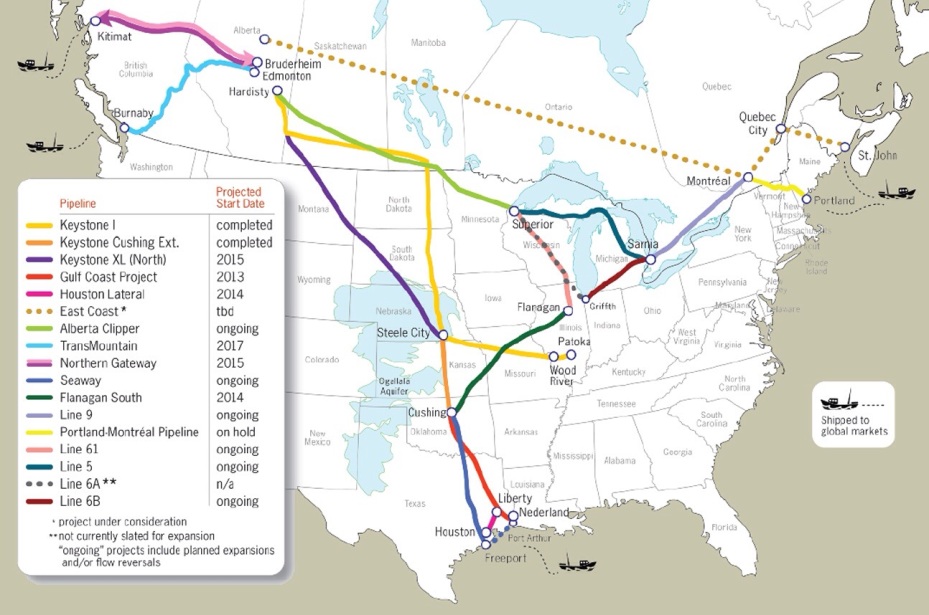
PIPELINE MAP
http://surfgreatlakes.wordpress.com/2014/01/19/breaking-oil-leak-on-massive-pipeline-pushing-tar-sands-through-the-great-lakes/
Recent Spills Include:
"January 2014: Enbridge Energy has just reported that their Alberta Clipper tar sands pipeline is being shut down because they have spilled over 5000 gallons of oil. The spill happened in Saskatchewan, Canada, and it is not yet clear what has caused the leak.
Enbridge Inc said on Saturday that it had shut
down its 450,000 barrel-per-day (bpd) Alberta Clipper pipeline, the
largest source of U.S. oil imports, after an oil spill at a Saskatchewan
pump station.
The estimated 125 barrel spill was mostly limited to the Rowatt pump
station, located south of Regina, though some windborne oil sprayed onto
the property of a nearby landowner, said Enbridge spokesman Graham
White.
Enbridge is investigating the cause along with the National Energy Board, said White, noting that the estimated size of the spill is preliminary and could change. "
Enbridge is investigating the cause along with the National Energy Board, said White, noting that the estimated size of the spill is preliminary and could change. "
http://www.reuters.com/article/2014/01/19/enbridge-clipper-idUSL2N0KT02220140119
Elk River, West Virginia Freedom Corp.
"A chemical spill into a West Virginia river has led to a tap water ban for up to 300,000 people, shut down bars and restaurants and led to a run on bottled water in some stores as people looked to stock up.
The federal government joined West Virginia Gov. Earl Ray Tomblin in declaring a disaster as the West Virginia National Guard arranged to dispense bottled drinking water to emergency services agencies in the counties hit by the chemical spill into the Elk River.
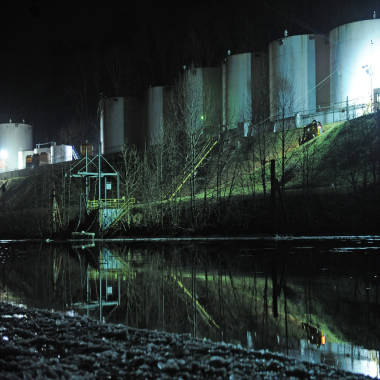 Federal
authorities are also opening an investigation into the circumstances
surrounding the leak of as many of 5,000 gallons of chemicals and what
triggered it, U.S. Attorney Booth Goodwin said Friday.
Federal
authorities are also opening an investigation into the circumstances
surrounding the leak of as many of 5,000 gallons of chemicals and what
triggered it, U.S. Attorney Booth Goodwin said Friday.The advisory was expanded at night to nine counties and includes West Virginia American Water customers in Boone, Cabell, Clay, Jackson, Kanawha, Lincoln, Logan, Putnam and Roane counties.
It followed a notice from the West Virginia American Water Company that its water supply had become contaminated, sending a strange licorice-like smell wafting through the surrounding streets."
http://usnews.nbcnews.com/_news/2014/01/10/22245996-west-virginia-chemical-spill-cuts-water-to-up-to-300000-state-of-emergency-declared?lite
October 2013:
North Dakota: "BISMARCK, N.D. (AP) — More than 20,000 barrels of crude oil have spewed out of a Tesoro Corp. oil pipeline in a wheat field in northwestern North Dakota, the state Health Department said Thursday.
State environmental geologist Kris Roberts said the 20,600-barrel spill, among the largest recorded in the state, was discovered on Sept. 29 by a farmer harvesting wheat about nine miles north of Tioga.
 Steve Jensen, the farmer, said he'd smelled crude
several days before the tires on his combines were coated with it. At
the apparent break in the underground pipeline, the oil was "spewing and
bubbling six inches high," Jensen said." http://www.huffingtonpost.com/2013/10/10/north-dakota-oil-spill-tesoro_n_4079323.html
Steve Jensen, the farmer, said he'd smelled crude
several days before the tires on his combines were coated with it. At
the apparent break in the underground pipeline, the oil was "spewing and
bubbling six inches high," Jensen said." http://www.huffingtonpost.com/2013/10/10/north-dakota-oil-spill-tesoro_n_4079323.html
Mumbai: "The oil spill on the Uran coast close to Mumbai is
larger than what was estimated, the Maharashtra Pollution Control Board
(MPCB) has said. The admission came two days after the leak of crude oil
from an ONGC pipeline. It took 12 hours to cap.
Initially
the MPCB estimated that 1,000 litres of oil had washed into the sea. On
Wednesday, it said the figure could be thrice more. “The leakage
started at 8.30 p.m. on Sunday and it was arrested around 11 a.m. the
following day. This means that a lot of oil has seeped into the sea. It
is definitely more than thrice the amount the ONGC estimated,” said Dr.
Y.B. Sontakke, MPCB’s regional officer for Navi Mumbai." http://www.thehindu.com/sci-tech/energy-and-environment/oil-spill-off-mumbai-worse-than-estimated/article5218266.ece
-----------------------------------------------------------------------------------------
Oils spills since 2010:
Niger Delta ExxonMobil Spill, Nigeria - May 2010
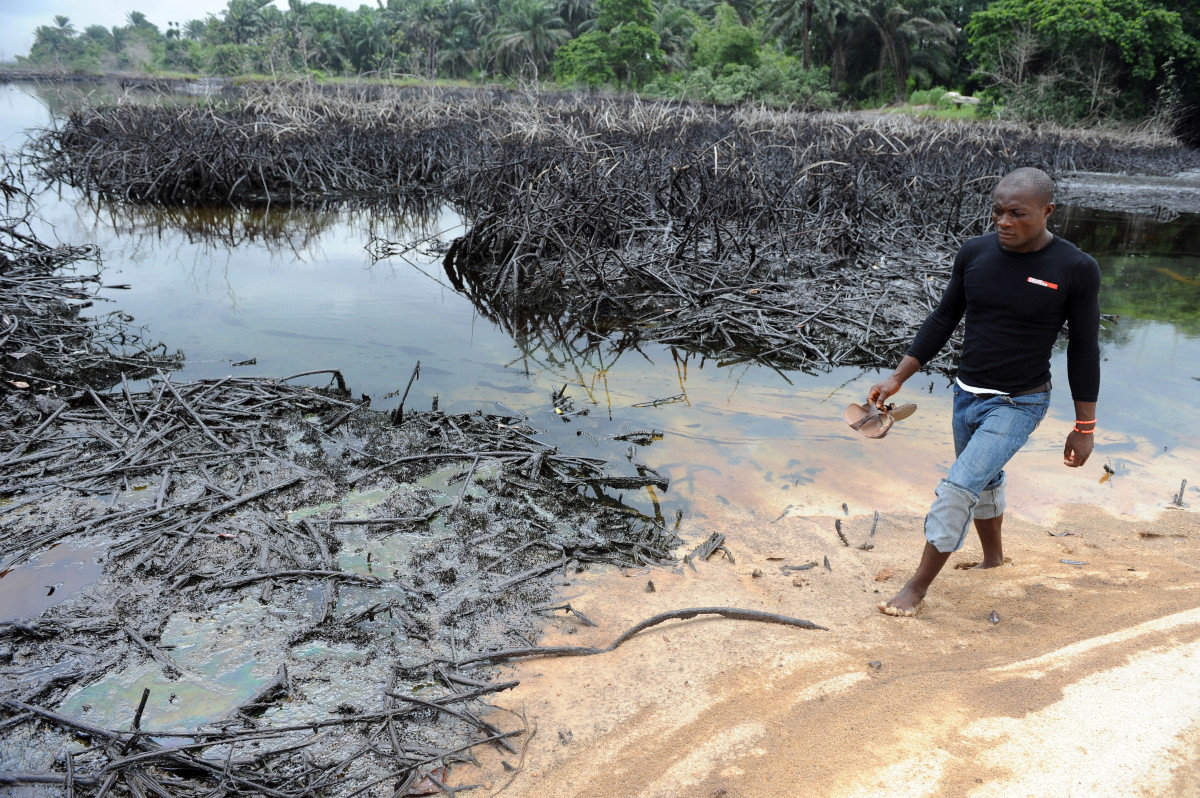 In Nigeria's Akwa Ibom State, an ExxonMobil pipeline ruptured on May 1 and spilled over a million gallons of oil, reported the Guardian. The leak continued for seven days before it was stopped.
In Nigeria's Akwa Ibom State, an ExxonMobil pipeline ruptured on May 1 and spilled over a million gallons of oil, reported the Guardian. The leak continued for seven days before it was stopped.HuffPost blogger Omoyele Sowore explained in July 2010 that an oil spill from ExxonMobil operations was nothing new to the country. He wrote that an "environmental catastrophe [had] been going on since December 2009." He described the toll on Nigeria: "There's oil on the surface of the ocean, wildlife coated in crude, fishermen losing their businesses."
In 2011, the Nigerian government said there had been more than 7,000 oil spills in the country between 1970 and 2000 that could take up to 30 years and $1 billion to clean up.
Trans-Alaska Pipeline Spill - May 2010
In
May 2010, several thousand barrels of oil spilled from the Trans-Alaska
pipeline "during a scheduled pipeline shutdown at a pump station near
Fort Greely," explained AP.
No injuries were reported and officials said the spill was likely "limited to the gravel on top of the containment area's line."
No injuries were reported and officials said the spill was likely "limited to the gravel on top of the containment area's line."
Red Butte Creek Spill, Utah - June 2010
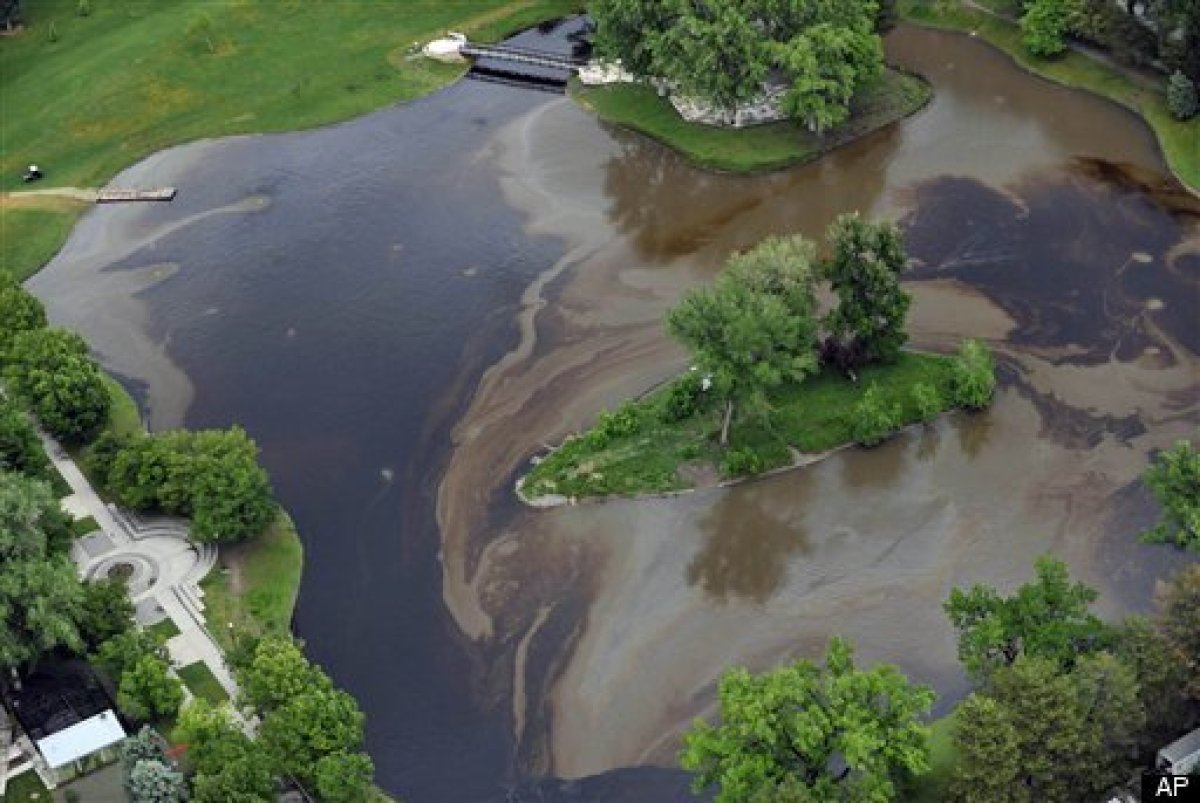 In June 2010, a Chevron pipeline ruptured and spilled oil into a creek near Salt Lake City, Utah.
In June 2010, a Chevron pipeline ruptured and spilled oil into a creek near Salt Lake City, Utah.It was first estimated that over 17,000 to 21,000 gallons spilled into the creek, which leads into the Great Salt Lake, reported AP. Around 150 birds were "identified for rehabilitation." The oil did not reach the Great Salt Lake, however.
Chevron was later cited for the spill, which released an estimated 33,000 gallons in total.
In March 2012, a group of 66 residents of a Salt Lake City neighborhood sued Chevron for damage caused by the Red Butte Creek spill and a smaller spill in December 2011.
Kalamazoo River Spill, Michigan - July 2010
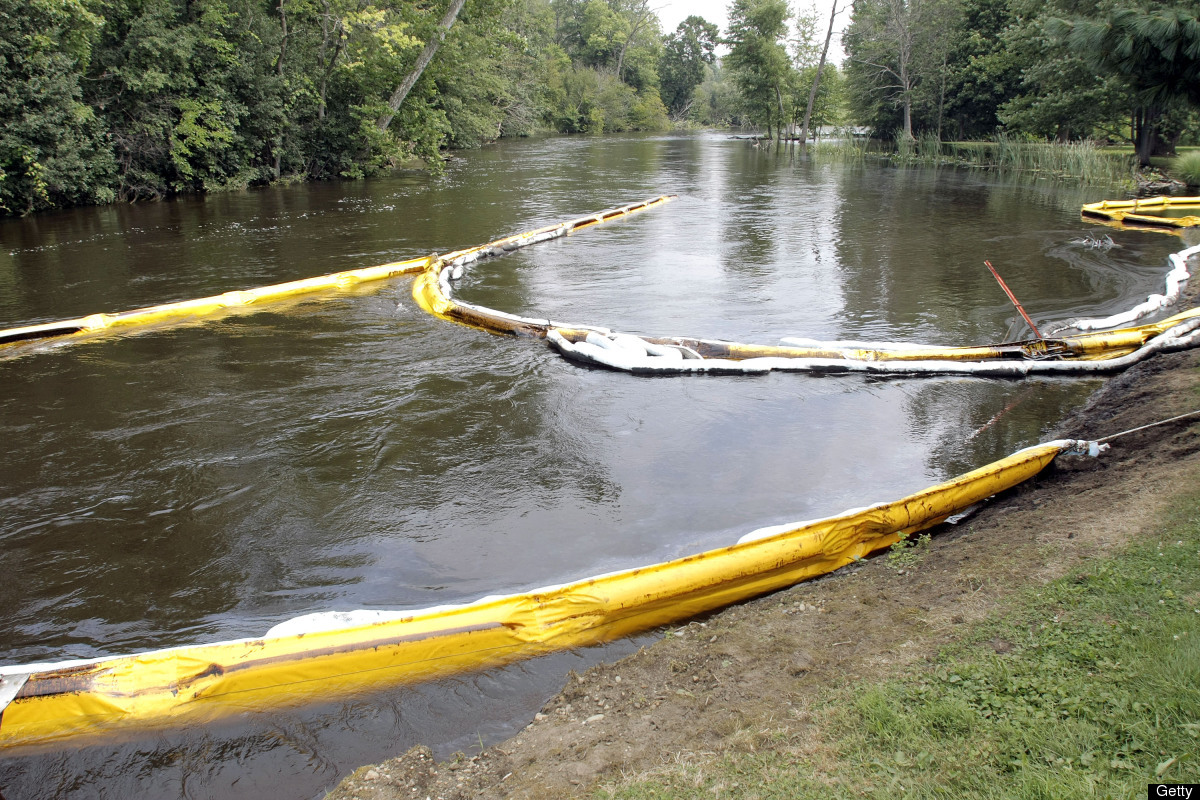 In late July 2010, an Enbridge pipeline in southwestern Michigan sprung a leak and spilled over 800,000 gallons of oil into a creek which flows into the Kalamazoo River.
In late July 2010, an Enbridge pipeline in southwestern Michigan sprung a leak and spilled over 800,000 gallons of oil into a creek which flows into the Kalamazoo River.By August, a regional EPA administrator said that significant progress had been made at the site, but "the agency cautioned that it will take months to complete the cleanup," reported AP.
By the end of September, the pipeline -- which travels from Ontario to Indiana -- was back in operation.
The EPA later reported that about 1.1 million gallons of oil were recovered, but pipeline operator Enbridge said that it would stick with previous estimates that only about 843,000 gallons were spilled.
Xingag Harbor Spill, Dailan, China - July 2010
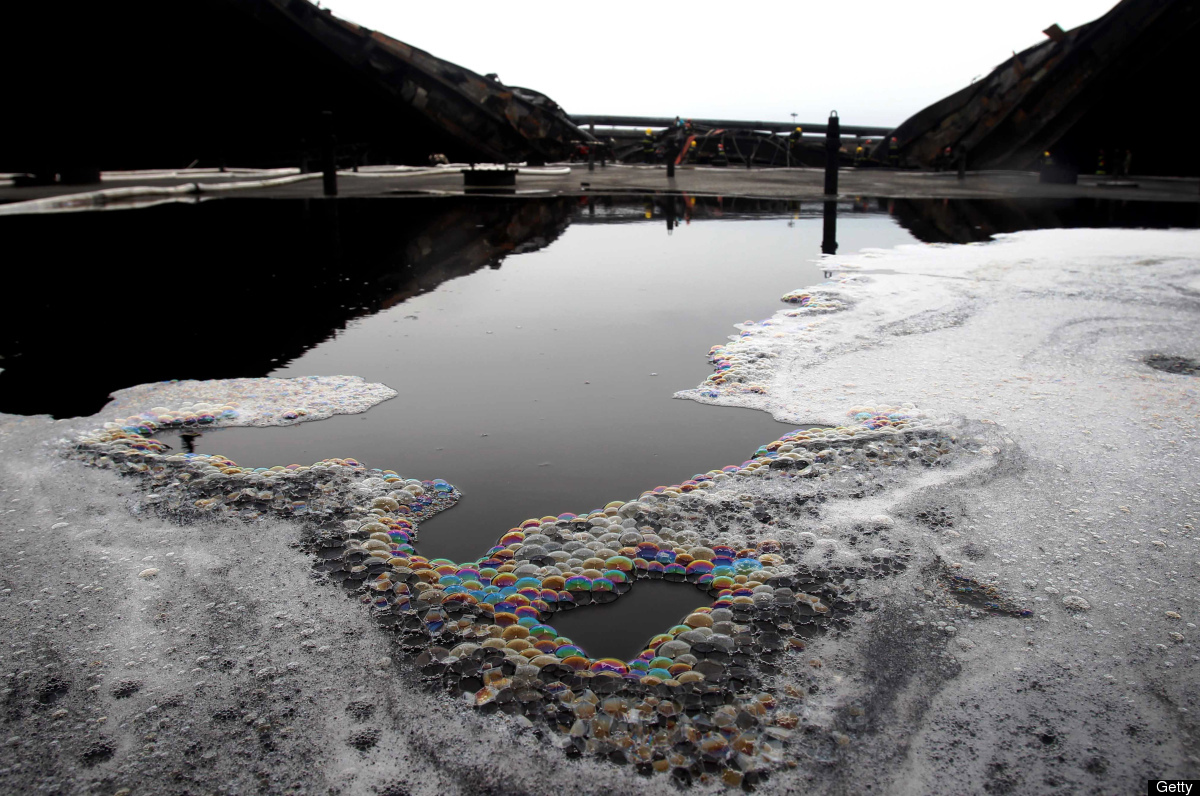 In July 2010, China experienced what was reported as the "country's largest reported oil spill" after a pipeline rupture near the northeastern port city of Dailan.
In July 2010, China experienced what was reported as the "country's largest reported oil spill" after a pipeline rupture near the northeastern port city of Dailan.
Several days after the spill, cleanup efforts were underway over a 165 square mile (430 square kilometer) area of the Yellow Sea.
The Chinese government reported that about 1,500 tons or 461,790 gallons of oil had spilled, but experts contended that the spill could have been "dozens of times larger," reported AP.
Peace River Spill, Alberta, Canada - April 2011
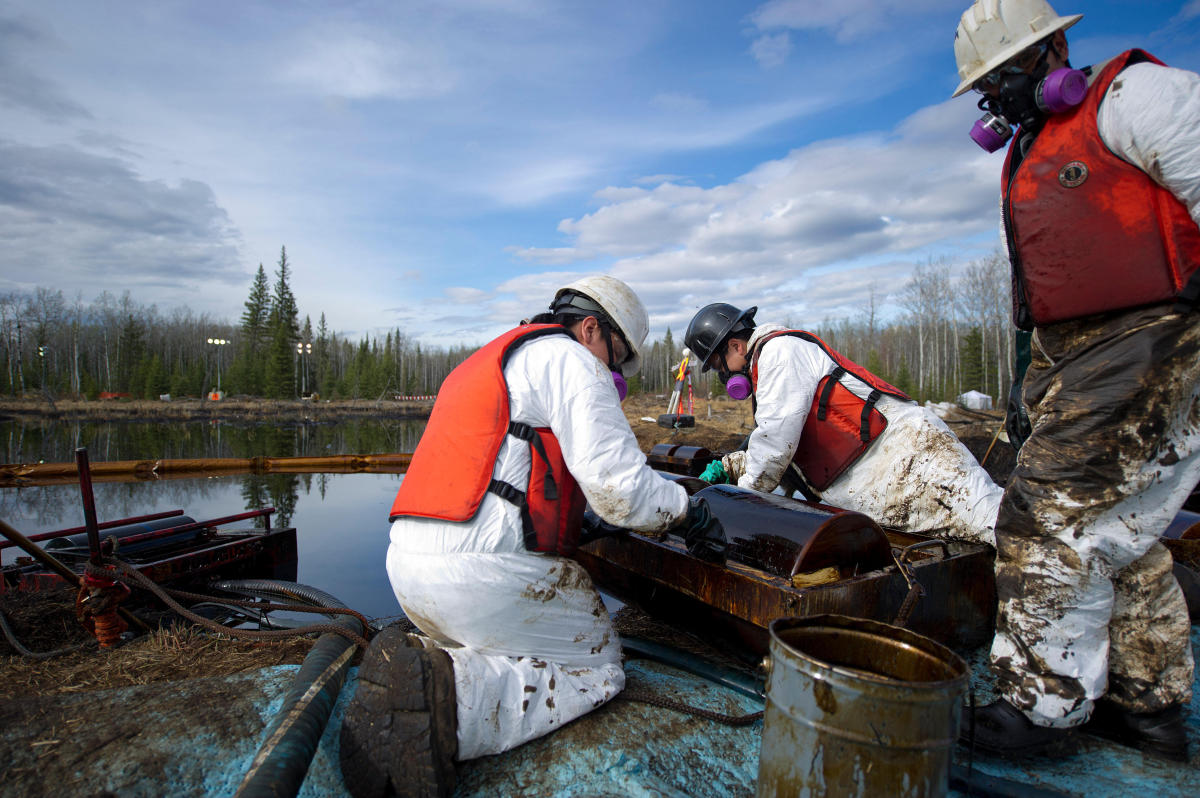 In late April 2011, a pipeline in northwestern Alberta began leaking, and created the worst spill in the province in 36 years, reported the Calgary Herald.
In late April 2011, a pipeline in northwestern Alberta began leaking, and created the worst spill in the province in 36 years, reported the Calgary Herald.About 1,176,000 gallons of oil were reportedly spilled from the Rainbow pipeline, which is operated by Plains Midstream Canada.
The Globe and Mail revealed that the pipeline operators "detected a potential problem nearly eight hours before halting the flow of crude." A nearby school in a First Nation community was closed after residents reported "nausea, burning eyes and other symptoms," and several animals were found dead.
In late July, Plains Midstream requested to re-open the pipeline and begin to ship oil to Edmonton again.
Bohai Bay Spill, China - June 2011
In June 2011, an oil spill occurred about 25 miles off the coast of China's Shandong province in Bohai Bay. A second spill followed in July.
In late August, it was reported that ConocoPhillips had discovered more oil seeps in Bohai Bay, although only "1 to 2 liters (a quarter to a half-gallon) of oil and drilling mud were being released each day."
The company reported that the 2011 spills released 29,400 gallons of oil and 2,500 barrels of drilling mud into the bay and that most of it was recovered. In September, China's State Oceanic Administration claimed that oil was still seeping underwater.
In early 2012, Texas-based ConocoPhillips reached a settlement deal with the Chinese government for $160 million.
In late August, it was reported that ConocoPhillips had discovered more oil seeps in Bohai Bay, although only "1 to 2 liters (a quarter to a half-gallon) of oil and drilling mud were being released each day."
The company reported that the 2011 spills released 29,400 gallons of oil and 2,500 barrels of drilling mud into the bay and that most of it was recovered. In September, China's State Oceanic Administration claimed that oil was still seeping underwater.
In early 2012, Texas-based ConocoPhillips reached a settlement deal with the Chinese government for $160 million.
Yellowstone River Spill, Montana - July 2011
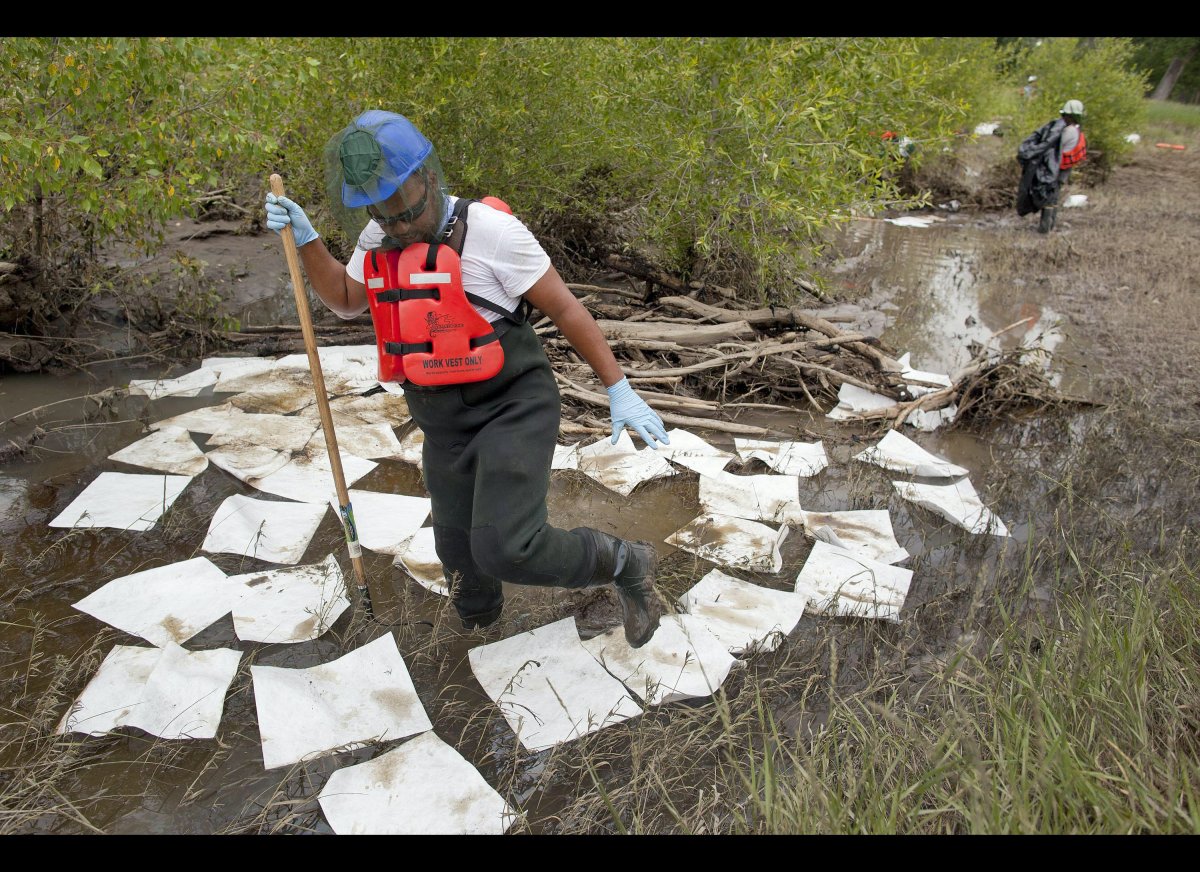 In July 2011, a pipeline beneath Montana's Yellowstone River ruptured and sent an oil plume 25 miles downstream, reported AP.
In July 2011, a pipeline beneath Montana's Yellowstone River ruptured and sent an oil plume 25 miles downstream, reported AP. Despite reassurances from ExxonMobil that the pipeline was safe, the July spill released what was originally estimated to be 42,000 gallons of oil. With other 1,000 workers assisting the cleanup, ExxonMobil estimated that it would cost $135 million to clean the river.
In January 2012, it was reported that ExxonMobil had increased its estimate of the spill size by 21,000 gallons. AP later reported the estimated spill size as 63,000 gallons.
CORRECTION: A previous version of this slide stated the estimated spill size as 63,000 barrels instead of gallons.
North Sea Spill, United Kingdom - Aug. 2011
In August 2011, an oil rig off the eastern coast of Scotland began leaking
oil into the North Sea. Royal Dutch Shell, which operates the Gannet
Alpha oil rig, initially reported that 54,600 gallons of oil were
spilled.
A second leak soon occurred, turning the spill into the worst in the North Sea in a decade, reported AP.
Several days later, Shell announced that it had "closed a valve from which oil was spilling into the North Sea," according to AP. The spill released about 1,300 barrels of oil, which spread out over a 2.5 square mile (6.7 square kilometer) area.
A second leak soon occurred, turning the spill into the worst in the North Sea in a decade, reported AP.
Several days later, Shell announced that it had "closed a valve from which oil was spilling into the North Sea," according to AP. The spill released about 1,300 barrels of oil, which spread out over a 2.5 square mile (6.7 square kilometer) area.
Campos Basin Spill, Rio de Janeiro, Brazil - Nov. 2011
In mid-November 2011, Brazilian authorities began investigating an offshore spill near Rio de Janeiro, reported AP.
Chevron initially reported that between 400 and 650 barrels of oil had spilled into the Atlantic, while a nonprofit environmental group using satellite imagery estimated that the spill rate was at least 3,738 barrels per day.
Chevron soon claimed full responsibility for the spill. The brazilian division's COO said, Chevron "takes full responsibility for this incident," and that "any oil on the surface of the ocean is unacceptable to Chevron," reported AP.
In December, Brazilian prosecutors announced that they were seeking $10.6 billion in damages from Chevron for the spill that leaked nearly 126,000 gallons of oil.
In March 2012, a Brazilian federal judge allowed prosecutors to file criminal charges against Chevron and Transocean and 17 executives from both companies were barred from leaving Brazil.
Chevron initially reported that between 400 and 650 barrels of oil had spilled into the Atlantic, while a nonprofit environmental group using satellite imagery estimated that the spill rate was at least 3,738 barrels per day.
Chevron soon claimed full responsibility for the spill. The brazilian division's COO said, Chevron "takes full responsibility for this incident," and that "any oil on the surface of the ocean is unacceptable to Chevron," reported AP.
In December, Brazilian prosecutors announced that they were seeking $10.6 billion in damages from Chevron for the spill that leaked nearly 126,000 gallons of oil.
In March 2012, a Brazilian federal judge allowed prosecutors to file criminal charges against Chevron and Transocean and 17 executives from both companies were barred from leaving Brazil.
Rena Spill, New Zealand - Oct. 2011
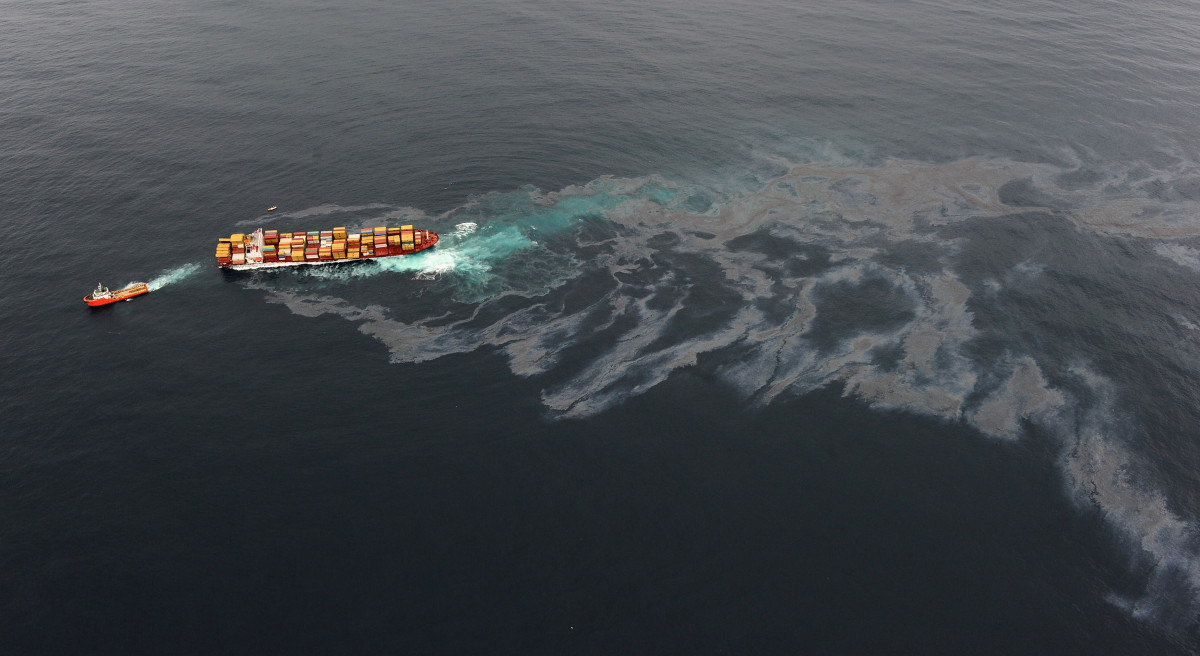 In October 2011, a Liberian-flagged cargo ship ran aground on a reef in Northern New Zealand and began leaking oil.
In October 2011, a Liberian-flagged cargo ship ran aground on a reef in Northern New Zealand and began leaking oil.With oil washing up on shore, a government minister deemed it the country's largest maritime environmental disaster a week later.
Although over 2,000 sea birds were killed by the spill that spilled about 400 tons of fuel oil, 343 little blue penguins were rescued and cleaned of oil. [Watch video of the penguins' release into the wild here.]
In January, half of the stricken Rena began sinking into the sea after breaking apart and spilling over 100 cargo containers.
Nigeria Oil Spill - Dec. 2011
The spill, which took place near the coast of Nigeria, was reported as "likely the worst to hit those waters in a decade," according to AP.
After two days, the spill had affected 115 miles (185 kilometers) of Nigerian coastline.
Several days after the December 20 spill, Shell reported that the leak -- which occurred about 75 miles offshore -- had been contained before it reached the Nigerian coast.
The spill, which covered 350 square miles of ocean at its peak, was reported as having released less than "40,000 barrels -- or 1.68 million gallons" of oil.
After two days, the spill had affected 115 miles (185 kilometers) of Nigerian coastline.
Several days after the December 20 spill, Shell reported that the leak -- which occurred about 75 miles offshore -- had been contained before it reached the Nigerian coast.
The spill, which covered 350 square miles of ocean at its peak, was reported as having released less than "40,000 barrels -- or 1.68 million gallons" of oil.
Red Deer River Spill, Alberta, Canada - June 2012
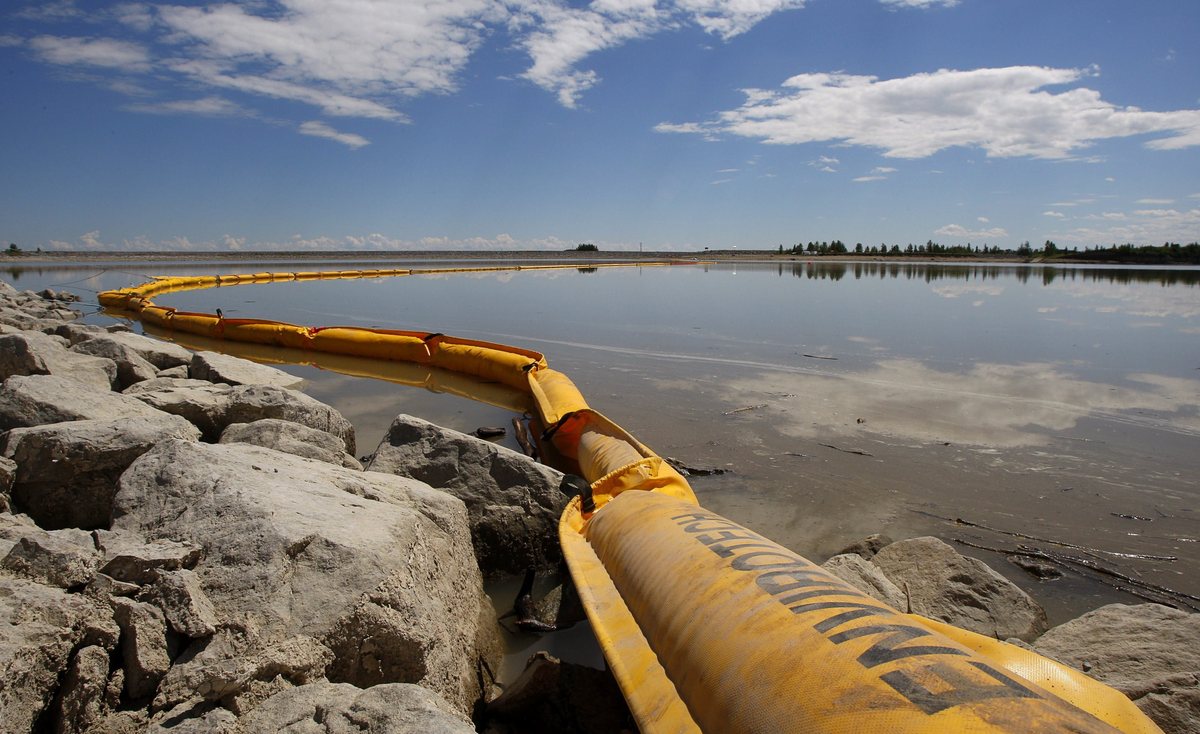 In June 2012, 126,000 gallons of sour crude oil leaked from a submerged pipeline into the Red Deer River in Alberta, Canada
before being swept downstream to the Gleniffer Lake and Reservoir, a
main source of drinking water for several communities near the spill.
In June 2012, 126,000 gallons of sour crude oil leaked from a submerged pipeline into the Red Deer River in Alberta, Canada
before being swept downstream to the Gleniffer Lake and Reservoir, a
main source of drinking water for several communities near the spill.A $75 million class-action lawsuit was filed against the owners of the pipelines, and in October 2012, the Canadian government banned fishing in the river in order to study the long-term environmental impacts of the spill.
This was the second major spill in the province and for the company that owns the line, Plains Midstream Canada, in two years. In 2011, 1.1 million gallons of oil leaked into the Peace River from a damaged pipeline in a remote corner of the province.
Arthur Kill Oil Spill - October 2012
In October 2012, 336,000 gallons of diesel fuel spilled into the Arthur Kill waterway as a result of Superstorm Sandy when two storage tank were damaged by 13-foot waves.
The spill contaminated the narrow band of water that separates Staten Island from New Jersey, releasing a strong chemical odor into the air as the diesel rose to the surface and evaporated.
Officials said a majority of the fuel spilled was captured by booms and that it was fortunate diesel spilled rather than crude oil because cleanup and dissipation would be much faster.
The spill contaminated the narrow band of water that separates Staten Island from New Jersey, releasing a strong chemical odor into the air as the diesel rose to the surface and evaporated.
Officials said a majority of the fuel spilled was captured by booms and that it was fortunate diesel spilled rather than crude oil because cleanup and dissipation would be much faster.
Mayflower, Arkansas Pipeline Rupture - March 2013
 In
late March 2013, ExxonMobil's Pegasus pipeline ruptured and spilled
about 5,000 barrels (210,000 gallons) of Canadian heavy crude oil into a
residential area in Mayflower, Arkansas. Exxon later removed a damaged 52-foot section of the pipeline.
In
late March 2013, ExxonMobil's Pegasus pipeline ruptured and spilled
about 5,000 barrels (210,000 gallons) of Canadian heavy crude oil into a
residential area in Mayflower, Arkansas. Exxon later removed a damaged 52-foot section of the pipeline.The company's cleanup efforts -- which reportedly included using paper towels -- were criticized in the media.
Local residents began reporting health issues not long after the spill. Arkansas Attorney General Dustin McDaniel has also expressed his concern for the health of Mayflower residents, reported The Huffington Post's Lynne Peeples.
One month after the spill, the same pipeline leaked one barrel of oil into a residential yard in Missouri.
Mississippi River Oil Spill - January 2013 (and February 2012)
In January 2013, a barge carrying 668,000 gallons of light crude oil
on the Mississippi River crashed into a railroad bridge. An 80,000
gallon tank on the vessel was damaged, spilling oil into the waterway,
which prompted officials to close the river for eight miles in either
direction.
The spill led to a backup of more than 1,000 barges and the accident is still under investigation. Workers finished clean-up in early February, but the Coast Guard said 7,000 gallons of crude oil are still unaccounted for.
This was the second collision of an oil tanker on the Mississippi in the past year. In February 2012 two barges collided which led to a five-mile wide closure.
The spill led to a backup of more than 1,000 barges and the accident is still under investigation. Workers finished clean-up in early February, but the Coast Guard said 7,000 gallons of crude oil are still unaccounted for.
This was the second collision of an oil tanker on the Mississippi in the past year. In February 2012 two barges collided which led to a five-mile wide closure.

























No comments:
Post a Comment